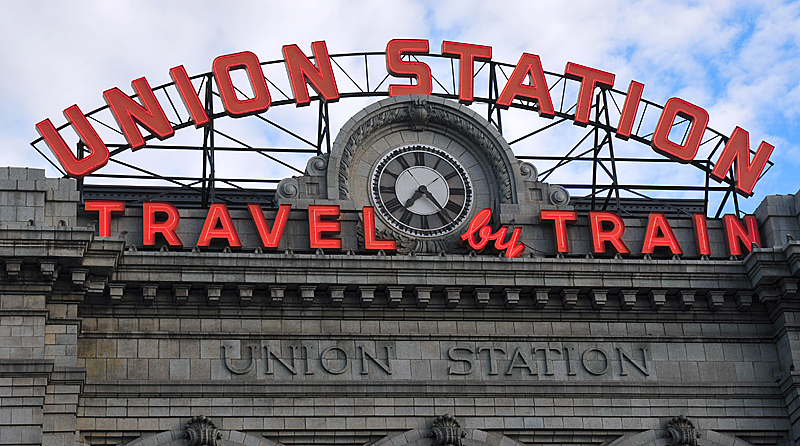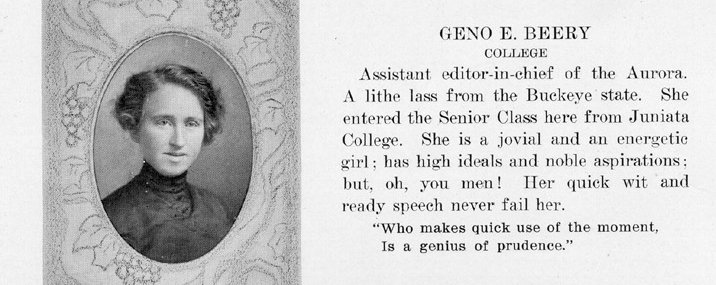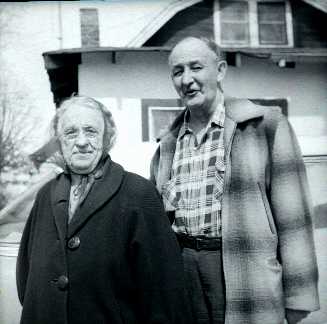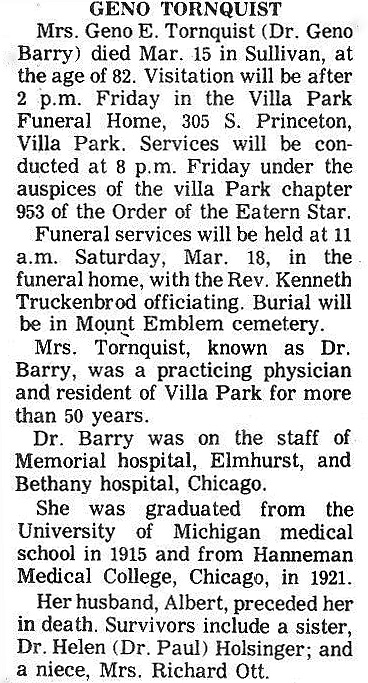






When I was born, my mother's doctor was Geno Ethel Beery; therefore, I was one of her babies too. For the first few years of my life, my mother took me to her for regular visits. "Docky," as she was always known, was quite a character. She practiced medicine at a time when few women did 1, and she was proud to have been the first woman to graduate from her medical school. It apparently took a formidible woman to tolerate the all male environment of her school at the time, but Docky definately fit the requirements.

Geno Beery's Manchester College yearbook entry (1913).
The Hahnemann Medical College & Hospital in Chicago was a school of homeopathy. By the time Geno Beery graduated in 1920, homeopathy was very much in decline in the United States. From a peak of 22 medical schools, the number was down to two by the 1920s. Nevertheless, her medical license was a standard MD. She referred to conventional physicians as "allopaths," and when she thought she could not handle a problem with her homeopathic remedies, she never hesitated to recommend one.
I remember the terror I felt on two occasions when another woman doctor was called in for me when I was quite ill. Dr. Marie 2 was all business, walked with a slight limp from childhood polio, and always seemed to produce an especially nasty looking syringe from her little black medical bag. And she always used it to give me a shot of penicillin in a very embarrassing place.
Homeopathy was founded by the German doctor, Samuel Christian Hahnemann (1755-1843). In 1810, he published the book, The Organon, outlining his theories. The basic principal of his theory of medicine was that a drug will be effective as a cure, if it produces symptoms like the disease when taken by a healthy person - "like cures like." Further, Hahnemann believed the more minute the dosage, the more potent. It may not have been very effective, but at least, few homeopathic patients ever died of the cure.
Being a homeopath long after the decline, Docky necessarily dispensed her own medicine from racks of brown bottles kept in her office. She would stuff a little cardboard pillbox so full that it bulged. All her pills seemed to be into one of two categorys: large pills or small pills. Otherwise, they all looked the same and tasted the same.
I remember climbing the long, straight, dark stairs to her second floor office at 15 East Park Blvd. -- just east of Ardmore and facing the Chicago, Aurora and Elgin tracks. An office visit always began with the same routine: stick out your tongue, show me your fingenails, let me take your pulse,... She talked to me pretty much as she would to an adult. I always thought it imparitave to respond verbally, or at the very least nod in agreement, to every one of her frequent interjections of "don'cha know?"
One visit to her in that office I remember especially well. After the usual preliminaries she produced a jar of pickles, gave me one and instructed me to try it. I liked pickles, but that one seemed intolerable. "Just as I thought," she said, "mumps."
Docky kept a couple scrapbooks of old clipped newspaper and magazine comics in her waiting room -- all were old even then. When we left, her traditional goodbye to me was always the same: "See you in the funny pages." When she retired (the first time), she gave me those scrapbooks.
Docky was no longer a young woman when I was born 3. I hadn't started school yet by the time she closed her office that first time. But retirement didn't suit her, and soon she opened another second floor office in the building on the northwest corner of Ardmore and Central Boulevard. We gave the scrapbooks back to her.
The new office suite was shared with our family dentist, Dr. Janike, who didn't believe in Novocain. I distinctly remember him saying, more than once: "Now this may hurt a little." The climb up the dark, creaking, straight stairs was equally daunting with the previous site. The waiting room was also dark, illuminated only by a single lamp and by the light that came through the pressed glass windows in the two office doors. There was an old leather sofa, and a large clock that ticked seconds. The ominous ticking, the strange antiseptic smells and the occasional screams of pain coming from the dentist's office made waiting there especially foreboding.
My mother and my big sister had been patients of Docky for years, and in my household, "Docky said, ..." was sufficient proof of any medical or health issue. Like a good loaf of bread, Geno Beery had a tough crust, but was really quite soft on the inside. The irascible and opinionated Doc. Adams on Gunsmoke always reminded me of her. She didn't like to admit it, but she was related to the actor, Wallace Beery 4. Her father, Elder Perry Hunsaker Beery, was a minister of the Brethren Church, and actors were definitely not considered respectable people in her family. Nevertheless, she looked and acted quite a bit like Cousin Wallace.
She, of course, made house calls. I remember seeing her frequently driving up our block in her aging, gray Hudson when Mrs. Arnold was very ill. Mrs. Arnold eventually died, and Docky took it pretty hard as I was told she always did. Docky and her husband, Albert Tournquist, eventually bought the Arnold house, which was just down the street from us at 16 South Illinois, as a home and as her final office. I remember her pitcher and ironstone china collection that covered the entire north wall of the dining room and the old parlor organ that dominated the living room.
My mother once told me that Docky didn't trust (regular) doctors much. She told Mother that when she had her appendix removed, she insisted on doing it with a local, and she had a mirror mounted so that she could keep her eye on the surgeons.
In those days, my family didn't have medical insurance - we didn't really need it. An office visit to Docky cost $2, perhaps $5 by the end of her career. The medicine was inexpensive and she even did her own lab work. She would produce a Bunsen burner and perform a urinalysis during the office visit.
Docky's husband, Al Tournquist 5, managed Marshant's Hardware Store on Villa Avenue - near the Chicago Great Western crossing and across the street from the feed store. I remember once being mortified after I addressed him as "Mr. Beery." I don't think I ever got over being embarrassed when I encountered him after that.

Docky and husband Al Tournquist at about the time of their retirement.
Finally, in the early '60s, Docky and Mr. Tornquist really did retire. They moved to a modest cabin on a lake in Missouri where my parents and I visited them once. Research indicates that later, Dr. Beery moved to Martinsburg, PA to spend her last years with her youngest sister, Helen, who was also a physician.
Geno Ethel Beery died March 15, 1972 at the age of 82.

Dr. Beery's obituary from the local newspaper -- they didn't even get her name right.
Footnotes
(1) The earliest information I have indicates she was living (and maybe practicing medicine) in Villa Park by 1927.
(2) Dr. Marie H. Wittler, pediatric physician, whose office was in Elmhurst.
(3) Geno Ethel Beery was born April 30, 1889 in Covington, Ohio.
(4) Wallace Fitzgerald Beery, movie actor, born April 1, 1886, died April 15, 1949.
(5) Albert Oscar Tornquist was born March 11, 1900, Hordeville, Nebraska. They were married Sept. 2, 1926. He died January 1972 in Sullivan, Illinois. There is reason to believe that Mr. Tornquist had an interest in medicine as well. However, it would seem that the exigenties of war and depression prevented him from ever completing his education.
Special thanks to the following people who helped me discover (or sometimes rediscover) facts about Dr. Beery: